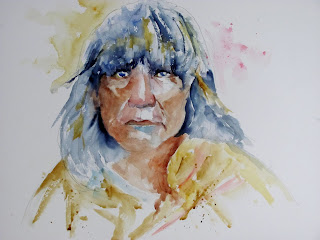Tuesday was my third portrait session at Bath College, drawing using white cartridge paper and willow charcoal. The only other tool needed, or allowed, was a putty rubber which is used to lighten areas and/or take the paper back to as near white as possible. At least I didn't have to carry much on the bus and bought the cartridge paper (very cheap) at the college shop plus a new putty rubber. On this occasion we had a different model.
John
Our starting point was to cover the paper with charcoal.
Not very promising is it! I did have a much better position this week. The model sits just to the back and right of the easel
The instructions were to draw the model with the charcoal stick or - as some of the more experienced did - form the shape just using the putty robber. We were specifically told the previous week that it had to be willow charcoal not compressed. As I have never done anything approaching this the latter was a step too far, so I used a piece of willow charcoal for the general shape and the features, using my measuring stick to try and get the overall dimensions and the distances between the features accurate. This stick is a green garden stake, slightly less than half the diameter of a pencil, around 10" long and with notches cut into it every 1/2 inch. I held this at arms length - arm very stiff and straight - while measuring. Prior to beginning Jackie laid out a series of reproductions of charcoal drawings, roughly A4 or smaller, both by famous past masters and some of her own. This was helpful to the newcomers, Pat and I, in establishing exactly what we were to try and emulate.
Two views - A2 Cartridge paper Charcoal
I've shown two views because I've struggled to get a good photographic representation. The original looks better in the flesh but I think the above are reasonable. Even my wife thinks it good. Actually she said excellent!
This was a fascinating session because it is all about shadow and light shapes and all you have to define them is a putty rubber and a piece of charcoal. As you know I am a `pure' (well not that pure!) watercolourist and how will this help my watercolour painting? I'm sure it will help portraiture. Downsides? Charcoal is dirty (very!) but fortunately Pat bought an aerosol of fixative at the shop and allowed me to `fix' my drawing so it arrived back home in more or less pristine condition.
Next week and the following it is back to painting with Sarah, the same model from the first two weeks. Having had one shot at painting her in watercolour I am determined to do better this time. I hope to be in a similar position - facing her more or less frontally or slightly to her right, and have been thinking hard how to improve my approach and get a better result.
Once again I found this a very stimulating session with Jackie quietly appearing at regular intervals to point out where things were not quite right or could be improved. Not a word of praise whatever. She is very unobtrusive but a hard taskmaster. When I was contemplating my original piece of putty rubber, black as the Ace of Spades, Jackie appeared and explained she had used the same one for years and showed how to knead it to a point to pick out whites.



















